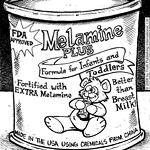Do We Really Need to Worry About Vitamin E Deficiency Diseases?
| Share on Facebook | Share on Twitter | Share on Google+ |
Vitamin E deficiency is a relatively rare condition, but when it occurs, it is devastating. The most common form of vitamin E deficiency is the hereditary disease cystic fibrosis, also known as CF.
His parents were advised by a "naturopath" that vitamin supplements might
be a cure-all, but the family doctor warned that they were probably a scam.
CF results from the lack of a protein that transports chloride ions out of the cells that make mucus. The result is chronic production of thick, sticky mucus not just in the lungs and throat but also in the digestive tract. In particular, mucus blocks the flow of enzymes made by the pancreas.
When the pancreas cannot release esterases, nutrients that are bound into a chemical group known as an ester cannot be broken down for entry into the bloodstream. All of the artificial forms of vitamin E that have chemical names that end in -ate are esters.
Children and adults who have CF get no benefit from d-alpha-tocopheryl acetate, d-alpha-tocopheryl succinate, d-alpha-tocopheryl linoleinate, or d-alpha-tocopheryl nicotinate supplements. These vitamin E supplements are less than useful, because they require valuable enzymes even to break the capsule or break down the pill.
Fortunately, there is a kind of vitamin E that doesn't need these enzymes to be used by the body, and that can "swim" through the thick mucus that blocks nutrient absorption in people who have CF. This is a product with the hard-to-remember name d-alpha-tocopheryl polyethylene glycol 1000 succinate.
If the name sounds like the product is entirely unnatural, it is. But this form of vitamin E is a formm that the body of a child or adult with CF can absorb. It's the only recommended vitamin E supplement for CF.
become so congested with pigment that his skin turned green. An emergency
gallbladder operation removed the stones, but just a few months later, even
though years of checkups had found no trace of heart disease, he
had a heart attack. And a few months after that, he was diagnosed with dementia.
CF is a relatively rare condition. Gallbladder disease, on the other hand, is relatively common. Every year, just in the United States alone, over three million women and 1.5 million men are treated for gallstones, but millions more do not know that they have them. At one time or another, nearly 50 per cent of all adults will have a gallbladder problem, and the conditions that create gallstones also interfere with the absorption of vitamin E.
The function of the gallbladder is to transport bile from the liver to the intestine. Bile dissolves fats. It gathers them into microscopic bubbles known as micelles, so they can flow into the watery bloodstream. Fats and water don't mix without formation of micelles, so the gallbladder is essential for the absorption of fat-soluble vitamins such as A, D, E, and K.
Both children and adults who have untreated gallbladder disease are at risk for developing serious, even life-threatening neurological conditions. Adults who have gallbladder disease are at increased risk of heart attack. But with this condition, the underlying problem is not a lack of the enzymes needed to process the forms of vitamin E used to make supplements. The problem is not getting enough vitamin E.
If you have gallbladder disease, you should consider a vitamin E supplement in an oil base. That is, you should take a capsule, not a pill. Taking at least 200 IU of alpha-tocopherol or alpha-tocopherol-succinate along with 200 mg of tocotrienols, in two divided doses taken at different times of day, can help compensate for the difficulty your body has absorbing vitamin E. (Click for more information on vitamin E dosage.)
You also may benefit from mixed carotenoids as a source of vitamin A, and encapsulated, oil-based formulas for vitamins D and K.
Selected References:
Shaffer EA. Epidemiology and risk factors for gallstone disease: has the paradigm changed in the 21st century?. Curr Gastroenterol Rep. May 2005;7(2):132-40.
Schwesinger WH, Diehl AK.Changing indications for laparoscopic cholecystectomy. Stones without symptoms and symptoms without stones. Surg Clin North Am. Jun 1996;76(3):493-504.
-
Skin CareMen Skin Care
-
Free ResourcesFree eBooks
-
Half of the modern drugs could well be thrown out of the window, except that the birds might eat them.Dr. Martin Henry Fischer
-
Featured Health SupplementTotal Balance
 contains approximately one thousand, two hundred and seventy five times LESS lead than 1 tablet of the Vitamin Shoppe product.
contains approximately one thousand, two hundred and seventy five times LESS lead than 1 tablet of the Vitamin Shoppe product.
-



















